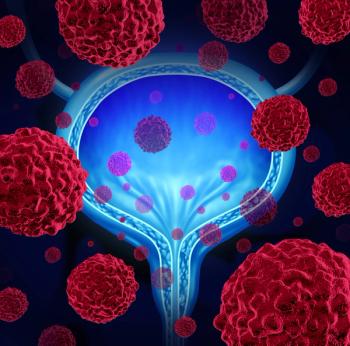
Sorafenib Plus Chemotherapy Promising in Muscle-Invasive Bladder Cancer
Sorafenib, gemcitabine, and cisplatin had promising activity and was well tolerated in patients with muscle-invasive urothelial bladder cancer.
A phase II study found that a neoadjuvant regimen of sorafenib, gemcitabine, and cisplatin (SGC) was well tolerated, with promising activity in patients with muscle-invasive urothelial bladder cancer (MIUBC).
“[Though] cisplatin-based chemotherapy is recommended in MIUBC, an unmet need is to identify new drugs or combinations to improve outcomes,” wrote study authors led by Andrea Necchi, MD, of the Fondazione IRCCS Istituto Nazionale dei Tumori in Milan, Italy. This study was presented as a
The study was an open-label, single-arm, phase II trial, including 46 patients with T2–T4a N0 urothelial bladder cancer. Patients received 4 cycles of cisplatin and gemcitabine, and sorafenib was administered daily until radical cystectomy. Patients had a median age of 62.5 years, most were male (39 of 46), and most had T2 disease (60.9%). Patients were followed for 2 years following radical cystectomy.
The 12-month progression-free survival (PFS) rate with the SGC regimen was 84.1%; at 24 months, the PFS rate was 73.3%. Among the 25 patients who were deemed responders to the therapy, the 12- and 24-month PFS rates were 95.5% and 90.4%, respectively. In both the full population and in the responders, the median PFS was not reached; in the nonresponders, the median PFS was 35.8 months, and the 12- and 24-month PFS rates were 71.4% and 54.7%, respectively (P = .0054 compared with responders).
Median overall survival was not reached in the full population or in either responders or nonresponders. In the full cohort, the 12- and 24-month overall survival rates were 88.4% and 82.8%, respectively; in the responders, these rates were 100% and 90%, respectively, while in the nonresponders they were 75.6% at both time points (P = .0587 compared with responders).
Twenty-nine patients had their tumor samples sequenced. Responders to the therapy were more likely to have mutations in DNA repair genes, the RAS-RAF pathway, the HER pathway, and others; nonresponders had more mutations in PI3K/mTOR genes, among others.
The regimen was generally well tolerated. Grade 3/4 thrombocytopenia occurred in 28.3% of patients, and grade 3/4 neutropenia (21.7%), diarrhea (8.7%), and asthenia (8.7%) were also reasonably common. Eleven patients (23.9%) required a sorafenib dose reduction, and four (8.7%) needed a chemotherapy dose reduction.
“The SGC combination was active and well tolerated in MIUBC,” the authors concluded, adding that translational analyses will help separate out the chemotherapy and sorafenib effects, and potentially help further refine treatment combinations in this malignancy.
Newsletter
Stay up to date on recent advances in the multidisciplinary approach to cancer.





